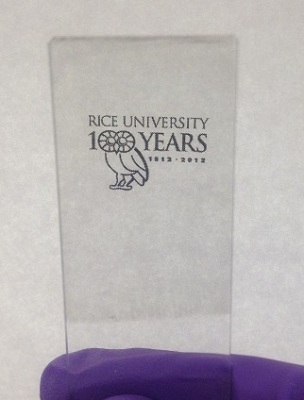Oct 30 2012
A Rice University team has hit upon a method to produce nearly transparent films of electrically conductive carbon nanotubes, a goal sought by researchers around the world.
 Thin, nearly transparent films of long carbon nanotubes have been produced at Rice University and show promise for flexible electronics. The researchers say their method is simple and scaleable for industrial use. (Credit: Francesca Mirri/Rice University)
Thin, nearly transparent films of long carbon nanotubes have been produced at Rice University and show promise for flexible electronics. The researchers say their method is simple and scaleable for industrial use. (Credit: Francesca Mirri/Rice University)
The lab of Rice researcher Matteo Pasquali found that slides dipped into a solution of pure nanotubes in chlorosulfonic acid (CSA) left them with an even coat of nanotubes that, after further processing, had none of the disadvantages seen with other methods.
The films may be suitable for flexible electronic displays and touchscreens, according to the paper published this month in the American Chemical Society journal ACS Nano.
“I think this could be the way that high-performance transparent electrodes are made in the future,” said Pasquali, a professor of chemical and biomolecular engineering and of chemistry. “The solution is straightforward. It’s a very simple process.”
The method is scalable to high-throughput processes like slot, slide and roll coating used by industry, Pasquali said.
A frustrating characteristic of nanotubes, particularly long ones, is that they attract each other in common solvents, making it a challenge to disperse them. Long nanotubes are believed to be the key to high-performance films.
Researchers have tried other ways to keep them from aggregating, Pasquali said. Functionalizing nanotubes – dressing them with chemicals – can make them less attractive to each other, but it degrades their desirable electrical properties. Combinations of surfactants and sonication have also been tried, but the nanotubes break during sonication, and the surfactant leaves a residue that cannot be washed away, he said.
These methods, combined with various means of mechanical coating, have been used to create nanotube films, but none with the level of quality achieved by the Pasquali lab. The Rice films which are made of nanotubes thousands of times longer than they are wide, remain electrically stable after more than three months, said graduate student and lead author Francesca Mirri.
The nanotubes, literally, had to pass an acid test. “(CSA) is the acid we typically use in our lab, so the first thing we say when we get a new type of carbon nanotubes is, ‘OK, let’s put it in acid and see what happens,’” Mirri said. In previous research, Pasquali’s lab had determined that CSA can dissolve high-quality nanotubes because the acid induces repulsive forces between the tubes that counterbalance the van der Waals force that draws them together.
Mirri and her colleagues produced films by combining single- or double-walled carbon nanotubes with CSA in various concentrations. They dipped glass slides into the nanotube solutions with a motorized arm to ensure even coating as the slides were steadily withdrawn.
They used chloroform to coagulate the acid and dry the slides, followed by a wash of diethyl ether. The researchers were surprised to find the chloroform did not disrupt the thin liquid layer. The result was a film several nanometers thick that provided the best tradeoff between transparency and sheet resistance, a measure of conductivity.
Mirri sees nanotube films as a viable alternative to indium tin oxide (ITO), the current standard conductive layer in transparent displays. “Everybody uses ITO for commercial applications, but the problem is it’s a ceramic and really fragile,” she said. “It’s not good for flexible electronics, and also requires high temperature or vacuum processes to produce; that uses more energy and makes it more expensive.
“Our thin film for something like a cell phone would need very little material — a few micrograms of nanotubes — so it wouldn’t be that expensive, but it would have similar properties in transparency and conductivity to ITO,” she said.
Co-authors are former postdoctoral researcher Anson Ma, now an assistant professor at the University of Connecticut; postdoctoral researchers Shannon Eichmann and Tienyi Theresa Hsu; former graduate student Natnael Behabtu, now a researcher at DuPont; graduate student Colin Young; and senior undergraduate Dmitri Tsentalovich, all of Rice.
The research was supported by the Air Force Office of Scientific Research, the Air Force Research Laboratories and the Robert A. Welch Foundation.